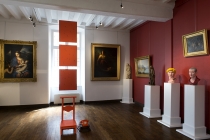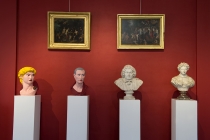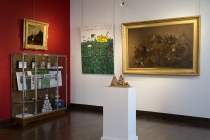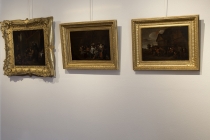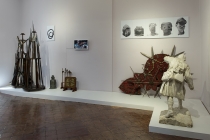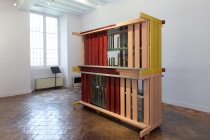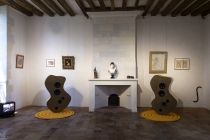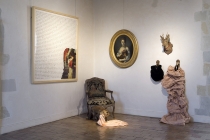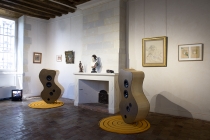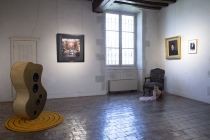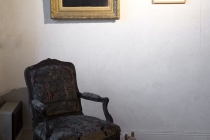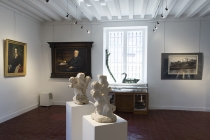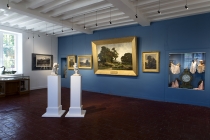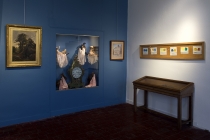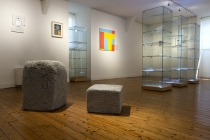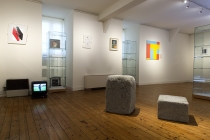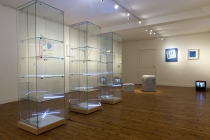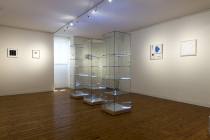Museum of Art and History, Château-Gontier, France.
30th May to 30th August, 2015.
For this exhibition, Hulaut and Clarke present artists who they consider to be references. The artists as curators search to produce conversations and weave a web with works from the museum’s permanent collection, a true cabinet of curiosities.
Richard Baquié, Jean-Yves Brélivet, Sophie Calle, Patrice Carré, François Courbe, François Curlet, Jason Dodge, EDS Collectif, Christelle Familiari, Hans Peter Feldmann, Robert Filliou, Bernadette Genée et Alain Le Borgne, Jacques Halbert, Ron Haselden, Sharon Kivland, Lucas L’Hermitte, Georgia Nelson, Karen Knorr, Cindy Sherman, David Shrigley, Ernest T, Laurent Tixador.
Thanks to FRAC Bretagne, FRAC Pays de la Loire, FRAC Basse-Normandie, Musée des Beaux-Arts de la Ville de Nantes, Musée Municipal de la Roche-sur-Yon.
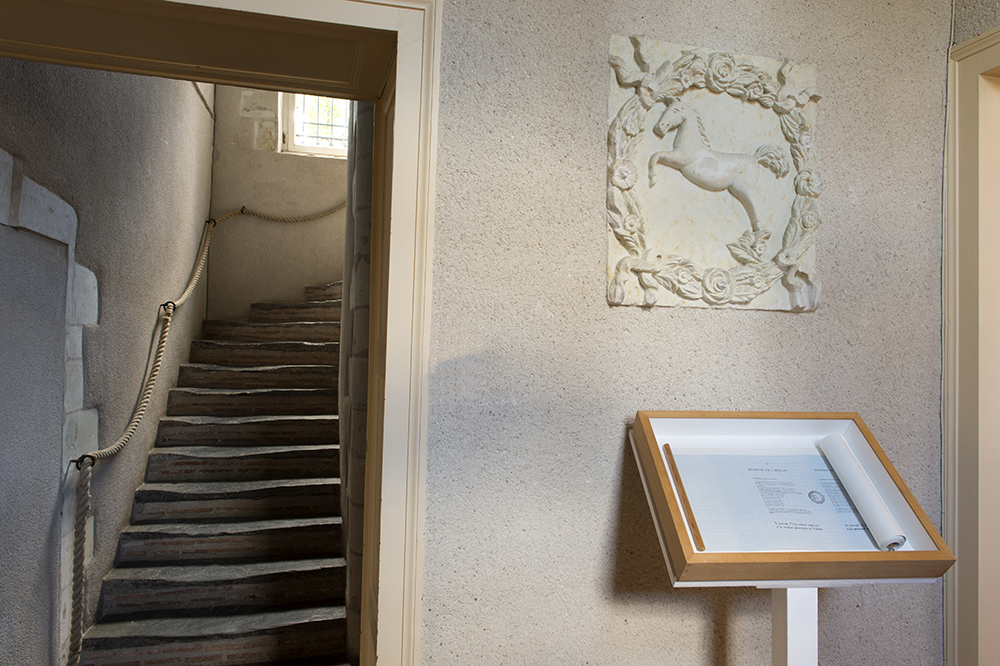
AH : The exhibition « Hôtel Particulier » or «Town House» begins with a work by Robert Filliou. He’s associated with the Fluxus group in the sixties. Having said this, like Beuys, he’s a bit apart. In a very clear manner, both Beuys and Fillion posed certain philosophical questions as to the nature of art. Fillion’s statement, «Art is what makes life more interesting than art» is no doubt one of the most quoted phrases in contemporary art.
DMC : It’s his principal of «permanent creation». Art isn’t simply something that one does in one’s studio before going home. Just as Beuys said, «everyone is an artist». What they were trying to say is that creativity exists in all of us, all the time. It’s simply up to us if we activate it or not.
AH : It’s also a philosophy of life. They didn’t make a separation between art and life. Filliou and Beuys were more than radical artists, the also had radical ideas about teaching art. The question wasn’t so much «how to teach art», more it was «teaching as art». These questions are essential, but Filliou in particular always treated these subjects with humour and a light, poetical touch. Filliou also established a protocol of artwork, «the principal equivalence». To be precise he said that a work of art could exist in one of three states, «well made, badly made or unmade».
DMC : Without a doubt, Filliou created this protocol to open up the realm of possibility for art. It seems right to evoke the subject today, because it brings to mind the enormous gap that has opened up between art and the public at large.
AH : In the room known as «la salle des Beaux Arts», we decided to invite Hans-Peter Feldmann, David Shrigley, Dr François Courbe and Jacques Halbert. To the point of obsession, Hans-Peter Feldmann collects images and objects that belong to our collective memory (postcards of the Eiffel Tower, pin-ups…). These ‘low quality’ objects are often reproduced ad infinitum, thus the disappearance of the ‘origin’ and of the sense. Also, his interventions are often very slight. Originality is after all supposed to be fundamental for the artiste.
Where certain artists would place an original or noble motif, Jacques Halbert uses the motif of the cherry, anywhere and on anything. In the manner of a travelling salesman, he took his «triporteur» right up to the front door of the Centre Georges Pompidou, selling small paintings and cakes. François Courbe, artiologist, positions himself as an art specialist in the medical sense of the word. Clown or idiot, it’s a way to conjure up the artist’s marginal place in our society.
DMC : David Shrigley has always refused technical prowess as a fundamental factor in art, and he does everything he can to prevent his evolution along this axis. In terms of content he’s not bad either, representing our world liberated of all logic other than his own. All said and done, he too raises the question as to the role of the artist with more than a slight sense of derision.
AH : This summer, all the sculptures from the classical greek and roman periods that are normally exhibited in «la salle des antiquités» have been lent to the Museum in Jublains. A year ago, when we began thinking about this project, we had to imagine this cluttered room as if it were totally empty.
DMC : This gave us the chance to take on a project without making a direct link to the museum’s permanent collection, even if all things said and done, these relations are always there. In any case, we thought almost immediately about Laurent Tixador. Laurent’s work is built as much upon «Pif Gadget» (which is maybe the 1970’s french equivalent of «boy’s own» magazines) as it is built upon art history. With an absurd logic, thinks up journeys and adventures and then puts himself to the test in a totally committed manner. These experiences are then restituted through incredible objects that Laurent manufactures, often with materials that he collects on the way.
AH : Laurent has always been fascinated by people who find themselves beyond the habitual lives. In fact that’s one of the reasons he became interested in «les poilus», the soldiers in the trenches during the first world war. Laurent is particularly interested in their artistic production, the art of up-rooted or displaced peoples. Thus for over ten years, Laurent has collected engraved artillery shells from this period. Recently while undertaking a residency in a Lycée in Brittany, Laurent managed to salvage some old dormitory beds that were destined to be thrown out.. He dismantled the beds and with the wood he built a vitrine to show his collection.
DMC : For the same room, we thought about Bernadette Genée & Alain Le Borgne. I discovered their work when the FRAC Pays de la Loire was setting up its new home in Carquefou. Bernadette and Alain organized an «exchange of competences» between the FRAC’s administrative team and the recruitment office for the army. I was taken aback by the project, not only by its immateriality but also by the manner in which it posed questions about our social networks long before Facebook and Twitter were invented. Most of our friends were doing anything that they could to avoid military service. Bernadette and Alain were looking for ways to break down this fictional barrier, motivated by a simple and honest and human curiosity about other people and their lives.
AH : Following on from that, they set about other rather surprising experiments that explore the relation between power and art. For this exhibition, they propose an installation comprising military objects that come from the museum’s permanent collection mixed with art objects hailing from their own production, notably a video from the project «Speechmusic» that represents the orchestra of the French Foreign Legion in concert, with all the musicians wearing their battle fatigues. The violin soloist is quite remarkable in himself, not only through his musical virtuosity but also through his corporal presence.
DMC : «La salle de femmes», beautiful as it is, seemed to us to be almost condemnable in our age. Apart from an endearing drawing of a mature woman by Camille Claudel, the installation plays to the male gaze that rests upon another gender. Many contemporary women artists immediately sprang to mind. Sharon Kivland explores our sexual universe, both real and imagined, that is particularly rich in images and signs. She often uses found objects, like stuffed animals or delicate vintage lingerie, that she transforms manually by adding text through embroidery or other such techniques. Our hopes, our desires, our anxiety and our guilt do not escape her attention.
AH : Sophie Calle is above all known for her auto-fictions, but her interest in histories and narratives doesn’t stop there. Her piece «Le Major Davel» has its origins in another work which was almost entirely destroyed by a fire at the Musée des Beaux-Arts de Lausanne. As an enquiry, Sophie Calle asked all the museum’s invigilators what they could recall about the work. The screen print presented here is a restitution of that process.
DMC : Christelle Familiari began her art practice producing knitted objects that suggested the possibility of a certain sexual utility. The forms that she creates today are in a way more mysterious, both in their materiality and in their signification. Georgia Nelson also offers a different take on manual work that is only too often served for women, evoking a poetic and even dreamlike world.
AH : At the beginning of my work exploring different semi-fictional characters Cindy Sherman was an inspiration for me. I was captivated by the manner in which she progressively masked her identity. In the 1980’s she produced many self-portraits as though she was a star of B-series films. Today she has pushed her proposition towards the clown and other grotesque figures. The photograph that we borrowed comes is an early work from the corpus «Untitled Film Stills».
DMC : And then there’s our gentleman troublemaker. When visiting the museum for the first time, Patrice Carré announced that he too would like to do something in the women’s room. And so he made a pair of speakers to resonate with a rather delicate figurine found in the permanent collection. Patrice also proposed an original soundtrack for an imaginary film, that was played through these almost cubist speakers that in a way evoke «Les demoiselles d’Avignon» by Picasso.
AH : We also borrowed a photograph by Karen Knorr from the series «Connoisseurs». This image entitled «The analysis of beauty» shows two men looking through telescopes at the pictures in a museum. The telescopes rise up in a rather masculine, virile manner. The work seems to mock the absurd, gender-based way in which aesthetics have been established over the centuries.
DMC : In the end, Patrice Carré isn’t the only male artist that we decided to show in «la salle des femmes». There are also works by David Shrigley and Jason Dodge. I also want to point out that inviting contemporary artists to show in the museum wasn’t our only approach to this exhibition. We also moved around quite a few permanent works within the museum itself. The mother of Moses by Kristina Von Post went downstairs and the portrait of the writer Lucie Delarue-Mardrus by Lucien Lévy-Dhurmer took its place with her literary colleagues in «la salle d’histoire locale».
AH : «La salle d’histoire locale» is dominated by a row of grand romantic landscape paintings by Tancrède Abrahams in the XIXe century. Incidently, he was also the first curator of the museum. Over the years, other paintings had been hung around his works, without much thought as to the overall effect. We really wanted to take this opportunity to reorganize the room and try to give sense to different lines of enquiry.
DMC : There are many representations of the town of Château-Gontier and its architectural heritage, notably the paintings by Gustave Dennery and Alfred Bourel-Latouche. In the reserve we discovered a river scene painted onto a window blind by local artist, François Héron. François taught at the «Lycée des Métiers de la Mode» in Cholet. He died suddenly two years ago and we thought it was important to render hommage by re-exhibiting his work.
AH : In this room there are also many glass cabinets protecting a variety of military objects collected by the General Gérard during the «Indochine» wars. Bernadette Genée and Alain Le Borgne discuss openly the ambiguous relation between the military and art, and war as a vector in the displacement of artifacts. During one visit to the museum, Alain told us about the history of «landscape» in painting, and how the roots of this art were to be found in ancient military actions.
DMC : In the collection FRAC Bretagne, we found a work by Richard Baquié entitled, «Battles, 1989». It’s a series of twelve watercolour paintings. On each leaf of paper, two zones of color fight it out to dominate the «No man’s land» that separates them. It’s not common to find an abstract painting articulated through military vocabulary, thus it seemed pertinent for us to include it. In the same collection we had a similar reaction to a work by Jean-Yves Brélivet. Is it a sculpture, a dummy, or a decoy? Is it painting or camouflage?
AH : The museum is a veritable cabinet of curiosities. Major works are hung next to paintings by relatively unknown artists. Works of art and hand-crafted objects mix with weaponry. Classical greek marble sculptures find themselves right next to bric-a-brac that you might find in a car-boot sale. This type of melting pot is an inspiration for our generation. At the end of his stay in Château-Gontier, François Curlet imagined a pair of rather surreal clogs, with the «Nike» logo burnt in through pyro-gravure … a mix of craft sport and art.
DMC : On the top floor is «la salle Pierre Logé». In his lifetime, Pierre Logé was a dedicated veterinary doctor and a passionate art collector. His collection comprising over two hundred works was donated to the town of Château-Gontier in 1998. There are works by Philippe Cognée, David Ryan, Carmelo Arden Quin, Eric Fonteneau … but because the room is small, we decided to put the focus on one specific part of his collection : minimalism and neo-geometric art.
AH : Quite a few vertical vitrines were to be liberated through the exodus of greco-roman artefacts. We chose to invest these glass cabinets with contemporary art that developed or deviated the simplicity and purity of modernism. Ron Haselden is above all known for his big installation work using «light» as a material. One could say that these are drawings that span out into space. Recently he has developed a series of works using strip-LED lighting, specifically for this type of vitrine. Lucas l’Hermitte is a conceptual artist. Each morning draws and shades a square on a piece of paper. The next day, he draws another square right next to the last one and tries to find exactly the same tone.
DMC : In the same room it was obvious to us to place another work by Patrice Carré, as the artist often plays with his surname, which in French means «square». Ernest T also plays with the absurd role of the motif in modern art. As for EDS Collective, the produce real / fictional events in works that combine performance and graphic design.
AH : And on another register, we borrowed two recent sculptures by Christelle Familiari. These are objects produced through the compression of older work such as the «l’étendue» that was commissioned for La Chapelle du Genêteil in 2003. Brutal version.

